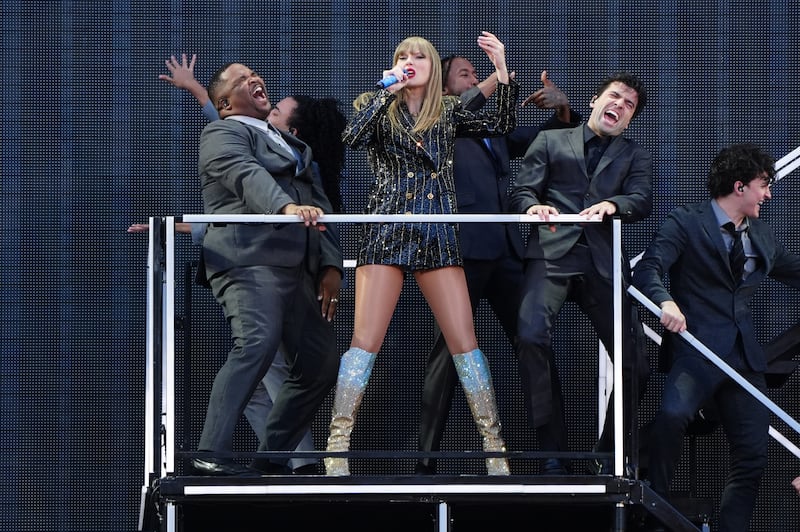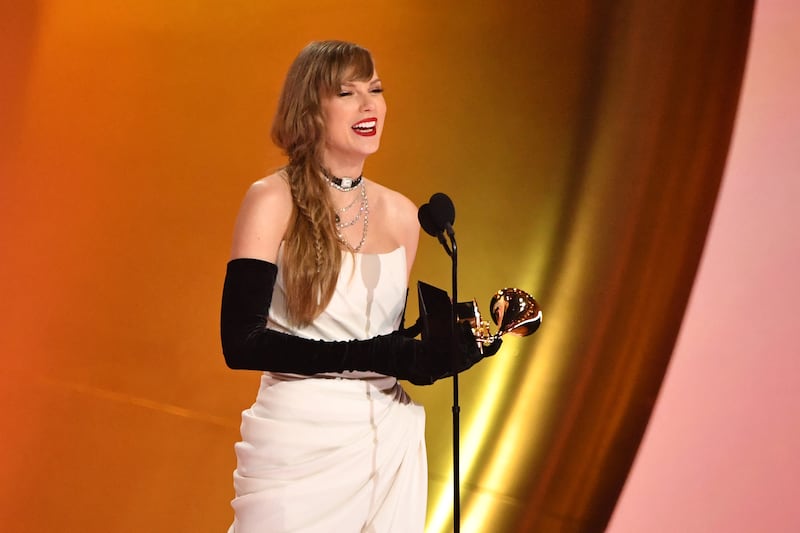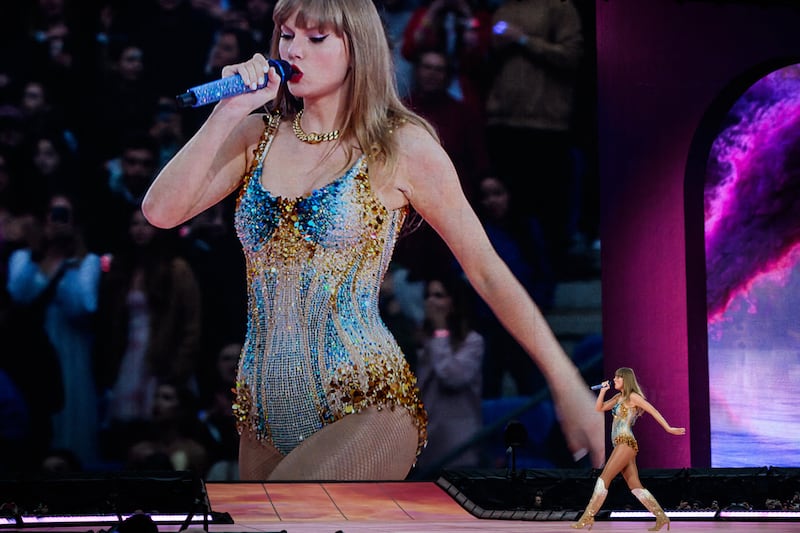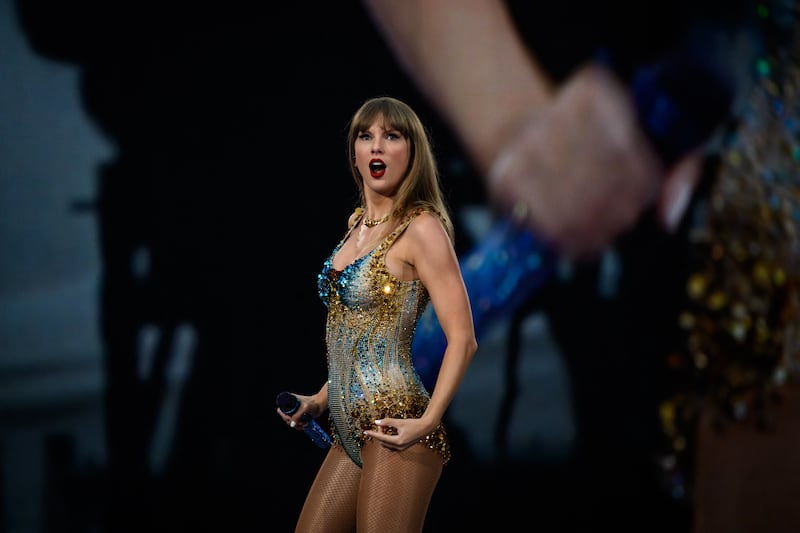“Taylor Swift is a gift to us all,” read the message in blue, sprayed with a wink, maybe, or to settle an argument. My local graffiti is not inclined to issue verdicts on pop – when I posted this one online, likes poured in. It was 2015, and Swifties were assembling into a force as formidable as their idol. Her choruses fizzed; her lyrics teased. Her stock was as high as the single eyebrow she raised. And yet the Swiftiedom that bubbled along then was quaint in scale compared to Taylor 2024 – a vast, shimmering enterprise staged by a generational talent who works hard, falls in love harder, and, like many famous women before her, never exhausts the supply of points she feels obliged to prove.
She “can do it with a broken heart”, she insists. “It” is the colossal 152-date Eras tour, a $2 billion-grossing career pinnacle retooled for its European leg with the crisp currency of new songs. For fans, it is an extravaganza of joy, catharsis and stamina. For Swift, as her April album The Tortured Poets Department appears to confirm, it is a Stakhanovite exercise that demands an ironic denial of self. To stay “in her glittering prime”, to put in performances as tight as the security she now requires, Swift (34) must be beyond disciplined, beyond distraction.
This mega-tour has morphed into a meta-tour. When 165,000 people follow the colour-coded routes to Dublin’s Aviva Stadium later this month, they will attend the 107th, 108th and 109th nights of Eras aware that the task of executing the 45-song, three-hour-plus set has already been integrated into her canon.

“Lights, camera, b**ch, smile / Even when you wanna die,” she instructs herself on I Can Do It With a Broken Heart. Like all the best electropop, it is effervescently depressive. How much of it is real? She struts to its satirically perky beat amid a sea of Hollywood feathers until the coda, when she cracks into rueful mocking of her own misery. “Try and come for my job,” she dares.
READ MORE
Make no mistake, it is remarkable that this is how GDP-swelling (allegedly), vote-influencing (potentially), stream-maximising (undoubtedly) behemoths of mainstream culture manifest now. To be the kind of artist who unleashes pitch-black couplets – “If you wanted me dead / You should’ve just said,” she sings on Who’s Afraid of Little Old Me? – while inspiring tweenagers to exchange friendship bracelets is an anthropological fascination and simply not a trick you see nailed every decade.
It doesn’t seem accidental that Swift’s achievement has occurred in this hope-challenged one. The Tortured Poets Department is layered, despondent and scathing. “F*** it, if I can’t have him / I might just die it would make no difference,” from the cosmically sad Down Bad, is presented as “teenage petulance”, but still. What a thing to siphon into stadiums at the peak of your popularity. What a very 2020s thing.
The land of Swiftonomics is untroubled by such content analysis. Here we can just have fun. A typical example comes courtesy of Barclays, which has forecast that the Eras tour will generate a £997 million (€1.17 billion) “boost to the UK economy”. I could apply the bank’s curious estimates for gig-adjacent outlays to her Aviva stint and say it hints at a “Swift lift” of €164 million for Irish consumer spending, but then I’d have to add that these numbers verge on nonsensical, especially if framed as a GDP bump, as this is disposable income that in a Swiftless universe would have been spent elsewhere.
Besides, nobody howling along to Champagne Problems will be thinking “wow, I can’t believe how much I’ve helped stimulate modified domestic demand”. Nobody dancing in a frenzy to Shake It Off will be dwelling on redistribution effects.

I understand the logic of grasping brand associations, the desire to bask in Swift’s refracted glow. I’ll tolerate the excitable professors with their lyric-parsing university modules. I applaud the seismologists scoring “Quake It Off” headlines by calculating that Swift’s Seattle concerts triggered “the equivalent of a 2.3 magnitude earthquake”.
But I also think that behind the media’s embrace of Swiftonomics lies an overt belief that the only way to confer legitimacy and seriousness on Swift is to employ the metrics of business and politics, almost as if no red-lipped, skater-skirted woman could otherwise have meaning.
True, she’s a finance-page regular for a reason. On her no-prisoners path to becoming the music industry’s bejewelled number-one artist, Swift vaulted into a nexus of disputes, emerging triumphant. Her three-year boycott of Spotify, in protest at paltry royalty rates, inflated CD sales of her album 1989. Her feud with the nemesis who purchased the masters of her first six albums prompted the genius scheme to re-record them. When she pulls levers, she yields dollar signs.
Signed to Universal, the world’s largest label, since 2018, her ascent has coincided with brighter fortunes for a recorded music industry now eyeing its tenth consecutive year of revenue growth. Her status as the North Star of the vinyl revival is sealed by turntable-free fans who buy multiple editions of her releases to frame as merchandise.

But this century of cultural splintering spews contradictions. A stratospheric success like Swift can seem ubiquitous while her songs remain easy to swerve. Eleven years ago, I wrote a column that began “Taylor Swift is a 23-year-old superstar”, because even by 2013 it was evident that quantifiable superstars had to be introduced. Now when people inform me they don’t like her “type” of music, as if it has a singular genre, it’s a giveaway – they haven’t heard it.
A precocious songwriter who released her first album aged 16, she has pursued dizzying shifts in style, segueing from twanging country guitar (her storytelling training ground) to playful glossy-pop (sometimes Swedish-produced) to third-person indie-folk (a pandemic special) to her current penchant for subdued synth-pop. Throughout this reinvention, her 274-song catalogue has been anchored by thematic consistency. The co-writers may vary, but Swift’s favourite motif, the one that underpins her relatability, stays the same: men.
We Are Never Ever Getting Back Together, the 2012 single that drew me to her with its skipping rhyme-like pulse, is a wit-stacked takedown of an ex-boyfriend who picks fights, then calls to make up. The Smallest Man Who Ever Lived (2024) is a stirring evisceration of an ex whose bait-and-switch act has left her perplexed and distraught. Even her debut single, 2006′s languid Tim McGraw, opens with a surprise sting. When a high-school love interest, an ex-in-waiting, tells her the way her blue eyes shine “puts those Georgia stars to shame”, she responds “that’s a lie”.
Undermentioned is the extent to which her songs are often more autofiction than autobiography. We live in an age of overliteral interpretations. No, the earnest fact-checkers say, she wasn’t raised in an “asylum”, but a Pennsylvanian Christmas tree farm, which we know from her song Christmas Tree Farm. There are many ways to deny female artistry, each of them dull.

As a victim of a public groping, a veteran of hostile hashtags and a woman whose feminism deepens with experience, Swift has long battled insidious rubbish. This billionaire, a self-styled “Miss Americana” who once lived for “pats on the head”, is now in her “f**k-off” era. She poses on the cover of Time with her baffled cat strung around her neck like it’s an out-take from one of her comedic music videos. She reopens old wounds on bonus tracks for the hell of it. She makes hay.
The deluded minority of Swifties who ordered her to dump one controversy-magnet boyfriend are not off-limits either. On But Daddy I Love Him, she indicates that she has had enough, asking to be spared the sanctimony of “judgmental creeps” – Swift might be a gift to her fans, but her fans are not always a gift to Swift.
Celebrity-stalking gossip outlets, meanwhile, harass her exes for their “side”. I’m deliberately leaving the men unnamed. If you know, you know; if you don’t, you won’t care. Still, I’m not above the drama. The morning The Tortured Poets Department dropped was delicious: here were 31 new songs to be inhaled like fresh episodes of a cherished soap opera, each burn and self-burn delivered like snippets of breaking news.

Haters, she chants, “gonna hate, hate, hate, hate, hate”. And in the US, they really do. If Swift ever succumbs to her paranoia, I won’t blame her. She hails from a country where theocratic Republican reactionaries have legislated away women’s rights, where seething misogynists have access to guns. Any woman taking control of her own narrative is instantly suspect.
Quelling such embedded hate is an impossible ambition, even for a record-breaking role model. Mostly I just hope that Swift is able to turn off the tap of adoration at a time of her choosing and that those who come for her job are up to it.
Soon, I will lurch southside for what will be my fourth Taylor concert, spangled up in the company of my niece and Swiftology-steeped sister, accessorised with bracelets my friend’s daughter has made for me. I’m ready for it. Life is frazzling, the world dispiriting, but Swift’s sense of agency is elating, her potency tangible. I’ll be happy if I can finish June with strained vocal cords, lost in the sparkling mass of Swifties who are lucky to have her, lucky to be there.
- Sign up for push alerts and have the best news, analysis and comment delivered directly to your phone
- Join The Irish Times on WhatsApp and stay up to date
- Listen to our Inside Politics podcast for the best political chat and analysis













